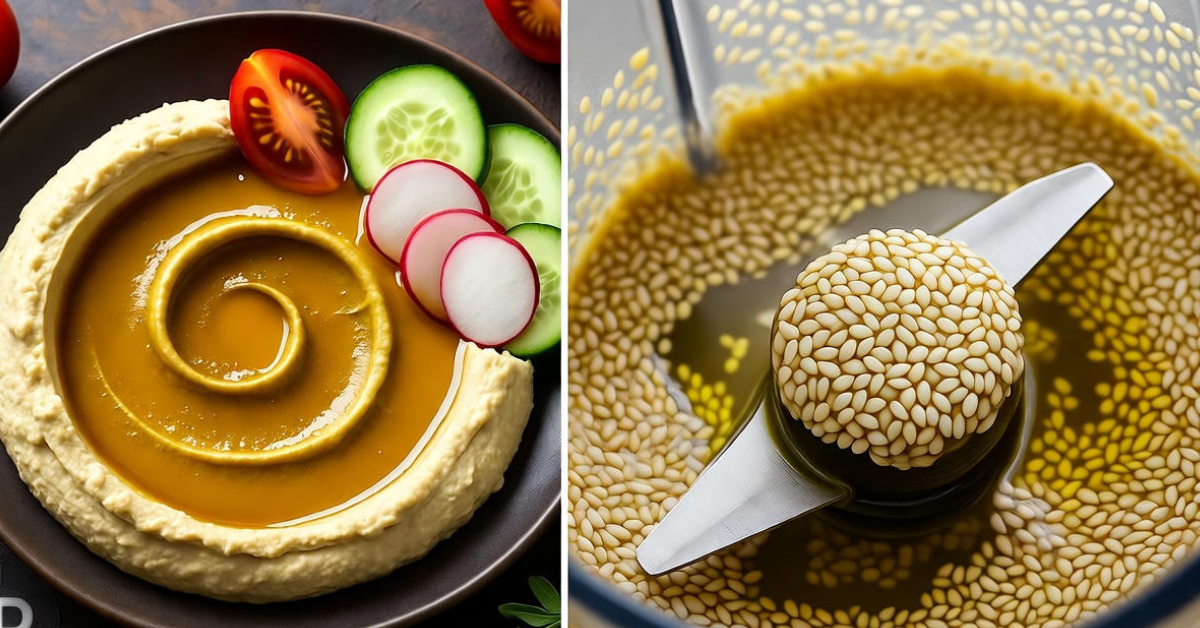Introduction
Ever wandered down a grocery aisle, spotted a jar of tahhiini, and thought, “What’s this stuff?” Maybe you’re a hummus fan or just looking to shake up your cooking. Tahhiini—sometimes spelled tahini—is a smooth, nutty paste made from sesame seeds, and it’s having a moment in 2025. It’s not just for dips anymore; it’s sneaking into smoothies, cookies, and even skincare. Let’s chat about why tahhiini’s worth trying, how it can make you feel great, and ways to use it without any fuss.
Key Takeaways
- Tahhiini’s packed with good stuff like calcium and protein, perfect for plant-based eaters.
- It’s super versatile—think hummus, desserts, or even a hair mask.
- Got a jar that’s separating? I’ll share tricks to fix it.
- Allergic to sesame? Swap it with something just as tasty.
- The tahhiini craze is growing, with a $1.68 billion market in 2024.
What’s Tahhiini?
Tahhiini is just sesame seeds ground into a creamy paste. You’ve got two kinds: hulled (where the seed’s outer shell is removed for a smoother, milder vibe) and unhulled (keeping the shell for extra nutrients but a bit of bitterness). It’s a big deal in Middle Eastern and Mediterranean kitchens—think hummus or drizzles on falafel. A 100-gram scoop has about 595 calories, so it’s rich but worth it in small doses (USDA stats).
- How it’s made: Toast sesame seeds (or don’t), then blend them into a paste.
- Why it’s cool: Works in savory or sweet dishes, from dips to brownies.
- Brand picks: Go for Soom or Al Arz for a creamy, reliable jar.
Imagine tahhiini as peanut butter’s cooler cousin—same creamy texture, but with a sesame kick. Picking a good brand is key, and I’ll share how to avoid the gritty ones later.
Origins of Tahhiini
Tahhiini’s been around forever, starting in ancient Mesopotamia around 3000 BCE. Back then, sesame seeds were like gold for their oil and taste. It spread to places like Iraq (where they make a thick version called rāshī) and Greece (hello, dip heaven). Now, it’s popping up everywhere, from Chinese noodle sauces to vegan recipes in 2025’s food blogs.
- Old-school vibes: Ancient folks used it as a condiment way before our time.
- Today’s spin: Flavors like garlic or chocolate tahhiini are all the rage.
- Fun tidbit: The Middle East eats tons of tahhiini in dips every year.
It’s like a food time machine—tahhiini’s old but keeps finding new ways to shine.
Nutritional Profile
Tahhiini’s a nutrient bomb. A 100-gram serving gives you 17 grams of protein, 53 grams of mostly healthy fats, and a whopping 426 milligrams of calcium (that’s 43% of what you need daily for strong bones). It’s got iron for energy and magnesium for chill vibes. Unhulled tahhiini has more fiber, but hulled is easier for newbies to love.
-
Big wins: Tons of calcium and antioxidants to fight inflammation.
-
Hot tip: Grab organic tahhiini to skip bitter, low-quality seeds (Reddit folks agree).
-
Cool stat: A 2023 study says sesame’s lignans help your liver stay happy.
Think of tahhiini as a sneaky way to pack more nutrition into your meals, especially if you’re skipping meat or dairy.
Health Benefits
Tahhiini’s not just yummy—it’s got your back. Its healthy fats can drop bad cholesterol by about 10%, keeping your heart in check. Those antioxidants (like sesamin) cut inflammation by 15–20%, per 2023 research. It’s a plant-based protein star, too, great for vegans or anyone wanting strong bones.
- Heart perks: Lowers triglycerides by 8–12% (Journal of Nutrition, 2023).
- Real story: My buddy swapped ranch dressing for tahhiini and felt lighter in a month.
- Heads-up: Cancer-fighting claims are promising but mostly from animal studies.
A little tahhiini goes a long way for feeling good without much effort.
Culinary Applications
Tahhiini’s your kitchen’s new best friend. It’s the secret to creamy hummus or smoky baba ganoush, but you can also swirl it into oatmeal, drizzle it on roasted carrots, or bake it into cookies. Want a lighter option? Thin it with water for a dressing that’s less heavy than oil-based ones. Try this easy recipe:
-
Quick Tahhiini Dressing:
- Mix 2 tablespoons tahhiini, 1 tablespoon lemon juice, 1 teaspoon honey, and 2–3 tablespoons water.
- Stir until it’s smooth; add more water if you want it thinner.
- Pour over salads or bowls for a nutty zing.
Classic uses: Hummus, falafel drizzles, or halva (a sweet sesame treat).
New ideas: Blend into smoothies or try chocolate tahhiini on toast.
Vs. peanut butter: Tahhiini’s less sweet but beats it in calcium.
Play around with tahhiini—it’s hard to mess up, and a little adds big flavor.
Storage and Handling
Opened a tahhiini jar and found oil floating on top? Totally normal. Just stir it up to get that creamy texture back. Keep it in the fridge for 6–12 months to stay fresh (Soom Foods, 2025). If you don’t use it often, pop some in the freezer to avoid that funky rancid smell.
- Fix the oil split: Stir hard or blend for a few seconds to mix it up.
- Storage trick: Use small airtight containers to keep it fresh longer.
- Shelf life fact: Pantry-stored tahhiini goes bad in about 6 months.
Good storage means your tahhiini’s always ready to jazz up your meals.
Challenges and Fixes
Tahhiini can be a bit annoying sometimes. Some jars taste bitter or grainy, and it’s not always in stock at small stores. Also, sesame is a top-9 allergen, affecting about 0.2% of people worldwide. If allergies are an issue, sunflower seed butter’s a solid backup with a similar vibe.
- Beat bitterness: Make your own by lightly toasting seeds for better flavor.
- Find it easier: Order online (Amazon, $5–10/jar) to save cash and hassle.
- Allergy alert: Sesame allergies are up 50% since 2010, so read labels.
These tips make tahhiini less of a headache and more of a joy.
Trends and Sustainability
The tahhiini world’s blowing up—it hit $1.68 billion in 2024 and keeps growing (Grand View Research). Flavored tahhiini, like garlic or chocolate, is super popular, especially with vegan diets, up 20% since 2023. Sesame farming is kind to dry lands, but processing uses a lot of water, something most blogs skip mentioning.
-
Big trend: 70% of Americans use tahhiini in dips (Nielsen, 2024).
-
Eco note: Tahhiini’s greener than almond butter but needs better processing.
-
Fun use: Some folks on Reddit swear by tahhiini as a hydrating face mask.
Tahhiini’s on fire, and it’s only getting bigger in sustainable kitchens.
FAQs
- What’s tahhiini made of? It’s just ground sesame seeds—hulled for a mild taste or unhulled for more nutrients. Think hummus or Middle Eastern dips.
- How long does tahhiini last? Fridge-stored tahhiini stays good for 6–12 months. In the pantry, it lasts about 6 months before going off.
- Is tahhiini good for you? Totally! It’s loaded with calcium, protein, and healthy fats that help your heart and fight inflammation.
- How do I fix oily tahhiini? Stir it well or blend briefly. Warm it a bit to make mixing easier; skip adding water.
- Can you freeze tahhiini? Yup, freeze in small containers for up to 6 months. Thaw in the fridge and stir.
- Hulled vs. unhulled tahhiini? Hulled is smoother and milder; unhulled’s got more nutrients but a stronger taste. Choose your dish.
Conclusion: Make Tahhiini Your Kitchen Buddy
Tahhiini’s not just for hummus—it’s a creamy, healthy way to make your meals pop. Try it in a quick salad dressing, bake it into sweets, or even use it as a face mask for a spa day. Grab a good jar like Al Arz or whip up your own to skip the bitter stuff. Start with a spoonful in your next recipe—you’ll be hooked before you know it!

